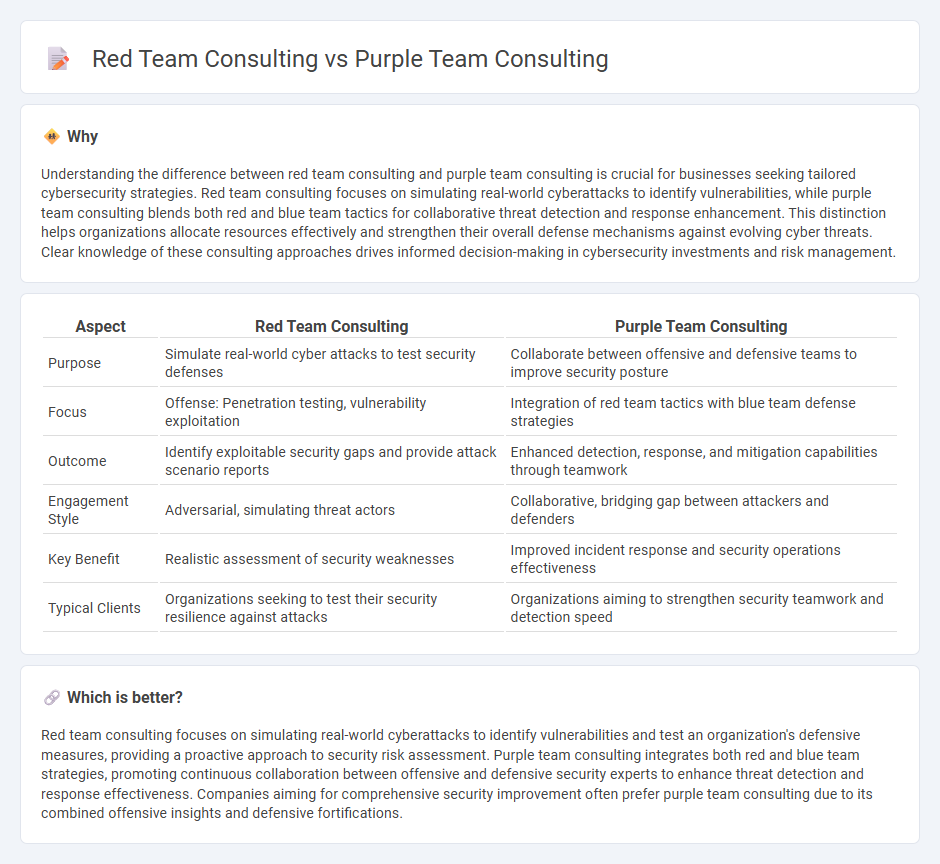
Red team consulting focuses on simulating real-world cyberattacks to identify system vulnerabilities and assess an organization's defensive capabilities. Purple team consulting integrates red and blue team strategies, fostering collaboration between attackers and defenders to enhance overall security posture through continuous feedback loops. Explore more insights to understand which consulting approach best suits your cybersecurity needs.
Why it is important
Understanding the difference between red team consulting and purple team consulting is crucial for businesses seeking tailored cybersecurity strategies. Red team consulting focuses on simulating real-world cyberattacks to identify vulnerabilities, while purple team consulting blends both red and blue team tactics for collaborative threat detection and response enhancement. This distinction helps organizations allocate resources effectively and strengthen their overall defense mechanisms against evolving cyber threats. Clear knowledge of these consulting approaches drives informed decision-making in cybersecurity investments and risk management.
Comparison Table
| Aspect | Red Team Consulting | Purple Team Consulting |
|---|---|---|
| Purpose | Simulate real-world cyber attacks to test security defenses | Collaborate between offensive and defensive teams to improve security posture |
| Focus | Offense: Penetration testing, vulnerability exploitation | Integration of red team tactics with blue team defense strategies |
| Outcome | Identify exploitable security gaps and provide attack scenario reports | Enhanced detection, response, and mitigation capabilities through teamwork |
| Engagement Style | Adversarial, simulating threat actors | Collaborative, bridging gap between attackers and defenders |
| Key Benefit | Realistic assessment of security weaknesses | Improved incident response and security operations effectiveness |
| Typical Clients | Organizations seeking to test their security resilience against attacks | Organizations aiming to strengthen security teamwork and detection speed |
Which is better?
Red team consulting focuses on simulating real-world cyberattacks to identify vulnerabilities and test an organization's defensive measures, providing a proactive approach to security risk assessment. Purple team consulting integrates both red and blue team strategies, promoting continuous collaboration between offensive and defensive security experts to enhance threat detection and response effectiveness. Companies aiming for comprehensive security improvement often prefer purple team consulting due to its combined offensive insights and defensive fortifications.
Connection
Red team consulting focuses on simulating real-world cyberattacks to identify vulnerabilities within an organization's security defenses, while purple team consulting integrates the offensive strategies of red teams with the defensive insights of blue teams to enhance overall cybersecurity posture. The connection lies in their collaborative approach; purple team consulting facilitates continuous feedback between red and blue teams, ensuring that vulnerabilities discovered during red team exercises are efficiently addressed and mitigated. This synergy accelerates threat detection, strengthens response capabilities, and fosters a proactive security culture within enterprises.
Key Terms
Collaboration
Purple team consulting integrates the offensive tactics of red team experts with the defensive strategies of blue teams to enhance cybersecurity posture through continuous collaboration and information sharing. This approach fosters a dynamic security environment by aligning threat detection, vulnerability assessment, and response efforts, ultimately improving organizational resilience against cyber attacks. Discover how purple team consulting can drive proactive defense and seamless cooperation within your security framework.
Adversarial Simulation
Purple team consulting integrates both red team (offensive) and blue team (defensive) expertise to enhance an organization's cybersecurity posture through continuous collaboration and information sharing. Red team consulting specializes in adversarial simulation by mimicking real-world cyberattacks to identify vulnerabilities and test incident response effectiveness. Explore how combining these approaches optimizes security strategies in evolving threat landscapes.
Security Assessment
Purple team consulting integrates offensive tactics from red teams and defensive strategies from blue teams to enhance overall security posture, emphasizing collaboration and continuous improvement. Red team consulting focuses exclusively on simulating real-world cyberattacks to identify vulnerabilities and test the effectiveness of an organization's defenses. Explore the distinct roles and benefits of each approach to optimize your security assessment strategy.
Source and External Links
Purple Team Assessments & Services - GuidePoint Security - Purple teaming involves collaborative exercises where red (offense) and blue (defense) teams work together in simulated attack scenarios to test and improve an organization's security posture and incident response capabilities through tailored, real-world visibility and expert guidance.
Purple Teaming | LRQA US - Purple teaming is a collaborative approach blending offensive and defensive security to enhance organizational cyber maturity, leveraging frameworks like MITRE ATT&CK and breach/attack simulation technology for scalable, repeatable exercises that strengthen detection and response capabilities.
What is a Purple Team in Cybersecurity? Roles & Benefits - Rapid7 - A purple team acts as a bridge between red and blue teams to improve threat detection and defense validation through continuous collaboration and iterative testing, focusing on optimizing security posture by learning from simulated attacks and defense reactions.
 dowidth.com
dowidth.com